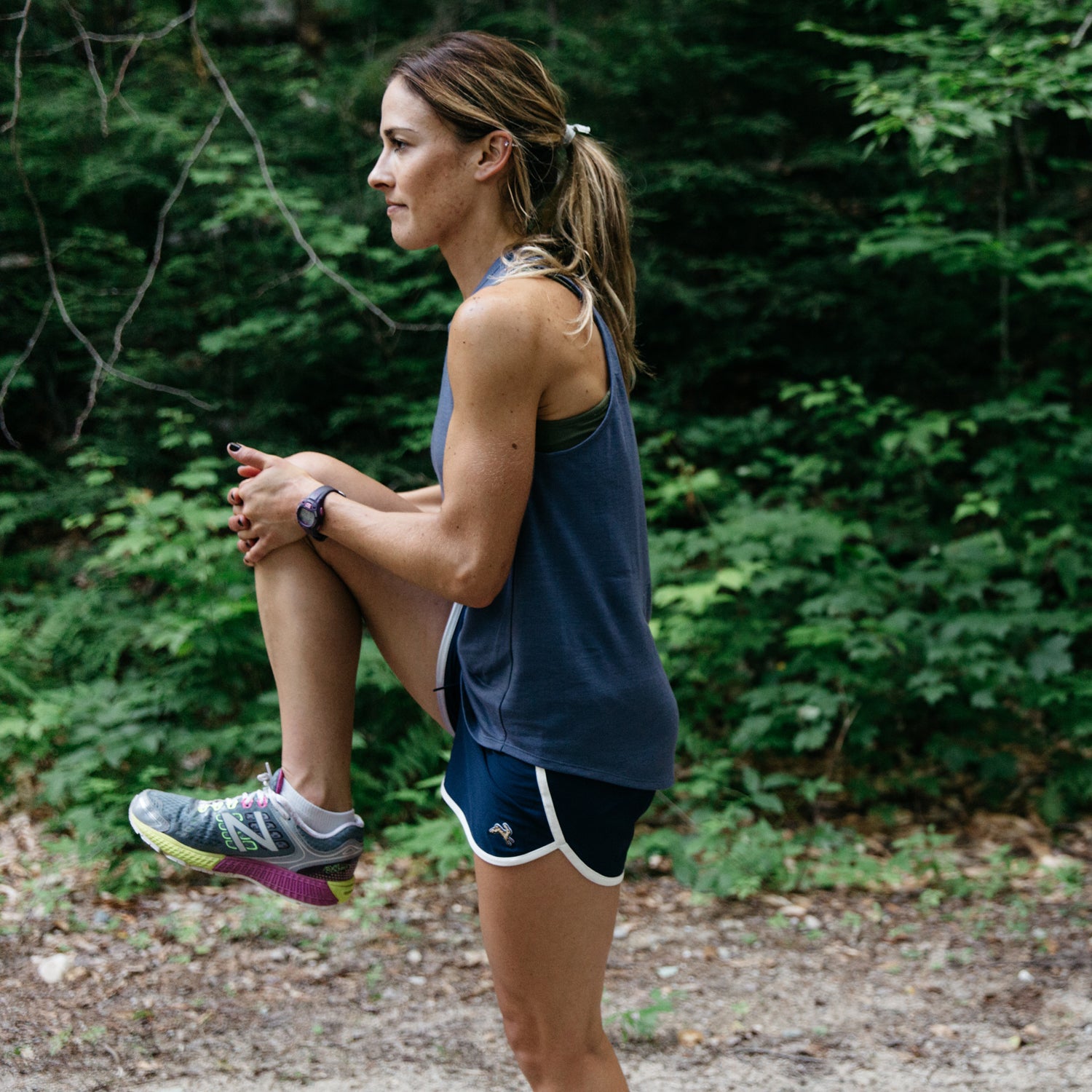From World War II until the late 1990s, athletes and daily plodders alike were told that the key to flexibility, injury reduction, and better performance was to stretch and hold. (Think of the old hurdlerтАЩs sit-and-reach.)
Then in the late 1990s the pendulum swung: researchers found that performance decreased when people exercised right after this type of тАЬstatic stretching,тАЭ when measured by power and force. One of these researchers, David Behm, found that those who held long static stretches before working out suffered from decreased balance and slower reaction times when they exercised immediately after stretching.
Today, most people who stretch before working out now perform тАЬdynamic stretchingтАЭ instead, which includes movements like crab walks, leg swings, and тАЬFrankensteinтАЭ leg raises. But Behm says this may be the wrong approach as well and the best way to stretch before exercise may be more nuanced.╠¤
Behm is a research professor at the School of Human Kinetics and Recreation at Memorial University of Newfoundland in Canada and much of his work is focused on what happens to muscles during exercise. But he first started thinking about stretching more than 15 years ago, when he first read a study that that found impairments in performance after using stretching as a warm-up. Behm wasnтАЩt just academically curious. The doctor╠¤had a brief career as a professional football player. (тАЬOne might say that I had a cup of coffee in the Canadian Football League,тАЭ he jokes). As a fullback, he often tried to make up for a lack of speed with strength training and lots of stretching, which likely made him the only guy in the CFL who could squat 500 pounds but also do the splits.
In a new study, Behm and colleagues wanted to know if previous research mimicked how people limber up in the real worldтАФand whether the findings and recommendations that stemmed from these studies thus were valid.
To do so, Behm and his co-authors dissected more than 200 stretching studies published in English between 1989 and 2014. They examined not only the type of stretching, but also the duration of the stretch.
The researchers immediately found problems. Participants were almost always tested in exercise after as much as 30 minutes of stretching. тАЬBut who does 30 minutes of stretching?тАЭ he asked. (Behm says he, too, was guilty of designing similar studies.)
WhatтАЩs more, participants often were told to hold stretches for long durationsтАФat least one minute per muscle group. People might do that during yoga class, but rarely right before they exercise, he points out.╠¤
When participants showed drops in performance, authors blamed static stretching instead of asking whether extended periods of static stretching might have caused the impairment.╠¤The new study doesnтАЩt spare dynamic stretching, either.╠¤When the researchers looked at 48 studies that together measured 80 kinds of after-stretching performanceтАФfrom sprint speed to jump heightтАФthey found only trivial positive changes.╠¤тАЬGenerally, not much happened,тАЭ said Behm.
The resulting ╠¤appeared in December online in the journal Applied Physiology, Nutrition, and Metabolism. ╠¤
Here are some more findings, and some new stretching advice from Behm:
Stretching: Do It
In case youтАЩre feeling whipsawed by all the advice, hereтАЩs the upshot: keep stretching. The benefits indeed seem to outweigh the costs, in terms of performance, range of motion, and injury reduction, the study found. Of course, to see any benefits, stretch the muscles relevant to your activity.
Do It for Five or More Minutes
To reduce injuries, youтАЩve probably got to stretch for more than five minutes in total, doing a few different stretches. When you do, the benefits of static stretching for helping your range of motion╠¤and reducing injury to your muscles тАЬat least balance, or may outweighтАЭ any slips in your performance you see, according to the authors.╠¤
Go LongтАжBut Not If You Go Long╠¤
DurationтАФhow long you should hold that static stretchтАФhas created more confusion than perhaps any other factor around stretching. Studies in North America and Australia have found that holding a pose for a minute or longer can lead to between a five- and 7.5 percent impairment in various measures of performance, when exercise is performed immediately after the long stretches, says Behm.
DonтАЩt let that stop you from doing deep stretching. тАЬWhat you really want to do, if youтАЩre a stiff old man, or -woman, or young person, you should do longer stretching, but you shouldnтАЩt be doing it right before you do your sport,тАЭ Behm advises. Yoga is greatтАФjust donтАЩt do a class prior a six-mile run. Think of deep stretching as another conditioning exercise more akin to, say, bench press, says BehmтАФand you wouldnтАЩt do five sets of bench press twice in one day.
Dynamic StretchingтАФShould You Even Bother?
Just because dynamic stretching didnтАЩt seem to greatly increase performance doesnтАЩt means itтАЩs worthless. тАЬDynamic stretching does help improve range of motion,тАЭ Behm says. It also тАЬelevates core temperature which can increase nerve conduction velocity, muscle compliance, and enzymatic cycling, accelerating energy production,тАЭ according to the recent study. Translation: unlike static stretching, which tells the bodyтАЩs muscles to calm, dynamic stretching excites your bodyтАЩs systems and gets the body prepared for further movement.
Behm recommends incorporating some controlled movement into your pre-workout routine. Dynamic stretching can be done close to your start of the activity.
Danny McMillian, a clinical associate professor at the University of Puget Sound who has written about stretching, agreed with the paper on this. тАЬUse SS (static stretching) as you see fit, but respect the fact that it might decrease nerve to muscle responsiveness. Therefore, follow SS with movements (and rate/loading of movement) that mimic your sport,тАЭ McMillian wrote in an email.╠¤
Get in the Goldilocks Zone
Just as weтАЩre not all the same, and not at the same level, not every person should be doing the same stretching, says Behm.
Consider Olympic sprinter Usain Bolt. HeтАЩs a high-performance machineтАФa Ferrari, says Behm, who talks about Bolt in his smart .╠¤Bolt is only interested in performance. He wants to be taut, tight, all suspension. He has less than 1/10 of a second to land, regroup and explode upward again.
For an elite like Bolt, static stretching right before a race would be a disaster, says Behm. After all, add 5 percent to BoltтАЩs time in the Olympics and he becomes Gerald Phiri of Zambia, who came in 15th place, or second-to-last, in the semi-finals, says Behm in his talk. тАЬFive percent is the difference between celebrity and anonymity. And it cost this guy millions of dollars.тАЭ╠¤
The difference, of course, is that the rest of us arenтАЩt Bolt. And weтАЩre not Ferraris. тАЬIf youтАЩre an elite athlete, then you might compromise your health for performance. Elite athletes are not always the epitome of health,тАЭ he says.
If you want to be healthy and fit for the long haul, donтАЩt be a Ferarri; be a Cadillac, says Behm. Cadillacs have soft suspension. When you hit a pothole in a Caddie, it absorbs the insult and keeps moving, he says. тАЬYou want your muscles and tendons to absorb the forces, so you're joints arenтАЩt taking a lot of beating.тАЭ╠¤
To be a Cadillac, тАЬStrive to be in the Goldilocks Zone,тАЭ says Behm. тАЬGoldilocks Zone means you want to have muscles that are just tight enough so that you get an efficient transfer of energy when you hit and go, in whatever sport youтАЩre doing. тАЬBut you want muscles that are just flexible enough, that it doesnтАЩt impair your stride length.тАЭ
How do you achieve that?
As part of your warm-up, Behm suggests doing four static stretches of six seconds each, in the relevant muscle groups youтАЩll be using. Combine that with some dynamic stretches, тАЬAnd you should be fine. You should be in that Goldilocks Zone.тАЭ
Hold That Stretch Longer Before You Hit the Mountains
Eccentric exerciseтАФsquash, downhill runningтАФcan tear up muscles. (ItтАЩs why your quads are fried after coming down the mountain on that weekend backpacking trip.) In their review, researchers found that static stretching showed a moderate performance benefit at moderate muscle lengths. Translation: take a few more static stretches when prepping to do eccentric activities in which the muscle lengthens as it is stressedтАФstuff like hiking downhill.╠¤
And what does Behm himself do?
тАЬWhen I got to play tennis, I stretch╠¤my hamstrings, my quads, my groin, my adductors, and then IтАЩd stretch my shoulder joint and lower back,тАЭ he says. тАЬUsually IтАЩd hold them about 20 seconds eachтАФthatтАЩs about seven minutes of stretchingтАЭ when added up, he says. Next, Behm will do some dynamic stretchingтАФswinging his leg from side to side, for instance. Finally, heтАЩll step onto the court and slowly, easily begin to hit balls to warm up.
As Behm holds that static stretch for 20 seconds, his subsequent performance on the court might decrease modestly. The question recreational athletes need to ask themselves is, тАЬWhatтАЩs the cost-benefit analysis?тАЭ he says. If youтАЩre a fraction slower to the ball, or you hit that ball a tiny bit slower, тАЬWell, who the hell cares?тАЭ he says. тАЬDoes it really make a difference in my game? Probably not.╠¤
тАЬBut it might make make a difference in whether I get injured or not.тАЭ


